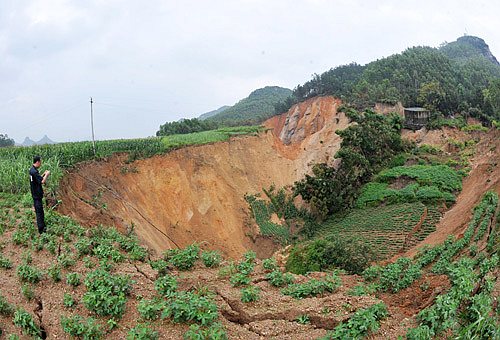|
 |
|
GEOLOGICAL DISASTER: A man looks at a growing pit caused by land subsidence in Laibin City, southwest China's Guangxi Zhuang Autonomous Region, on June 7. The sink-hole is one of many such cases reported across China since late April allegedly caused by karst collapse (ZHOU HUA) |
Recruiting Talent
China's central authorities have set down a more open policy to attract top-notch foreign talent to help promote economic and social development as well as the global competitiveness of the nation.
According to the National Medium- and Long-term Talent Development Plan (2010-20) released June 6, the government will work out favorable policies in terms of taxation, insurance, housing, children and spouse settlements, career development, research projects and government awards for high-caliber overseas talent who are willing to work in China.
The national plan, a blueprint for creating a highly skilled national work force over the next decade, aims to transform the country from being "labor-rich to talent-intensive."
Fewer Boys
The annual male-female birth ratio in China narrowed slightly by 1.11 points to 119.45 boys born for every 100 girls last year, the first drop since 2006.
The figure indicated the widening gender gap was slowing, Li Bin, Director of China's Population and Family Planning Commission, told a work conference on taking care of girls and sex divergence in Hefei, capital of east China's Anhui Province.
China has seen the gender ratio at birth increase since the 1980s and it has been recorded as high as 130 males for every 100 females in some provinces.
The Chinese traditionally hold a preference for male heirs, especially in rural areas.
Greener Landscape
The State Council, China's cabinet, approved guidelines that protect, restore and ensure the sustainable use of forests for the 2010-20 period on June 9.
Participants at the State Council meeting, chaired by Premier Wen Jiabao, reviewed and approved the guidelines for forest protection and utilization during the 10-year period.
The guidelines say China will increase its forest coverage to 223 million hectares by the end of 2020, or 23 percent of the national area.
The guidelines set a goal of increasing the nation's tree-coverage to 312 million hectares, or more than 32.5 percent of the national area, by the end of 2020.
Positioning System
China successfully launched its fourth orbiter into space on June 3, as a part of its indigenous satellite navigation and positioning network known as Beidou, or Compass system.
The launch was disclosed by a statement on the website of the Ministry of Industry and Information Technology on June 4. The satellite was launched from the Long March 3III carrier rocket.
It will join another three satellites in orbit to form a network that will eventually consist of 35 satellites, said the statement.
The plan says the system will provide navigation, time and short message services in the Asia-Pacific region sometime around 2012. It will be capable of providing global navigation services by 2020.
China started to build up its own satellite navigation system to break its dependence on the U.S. global positioning system in 2000, when it launched two orbiters as a double-satellite experimental positioning system. | 